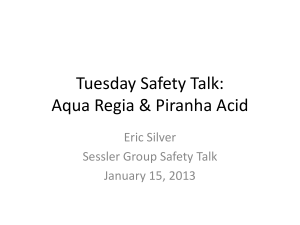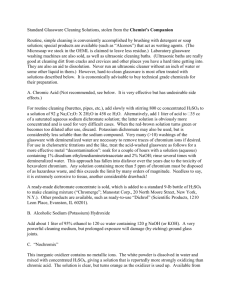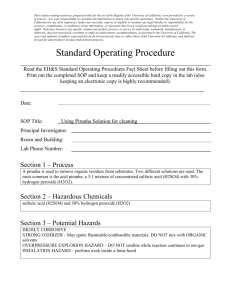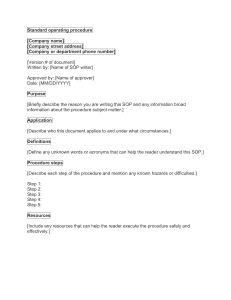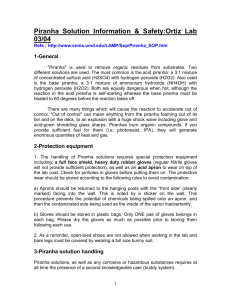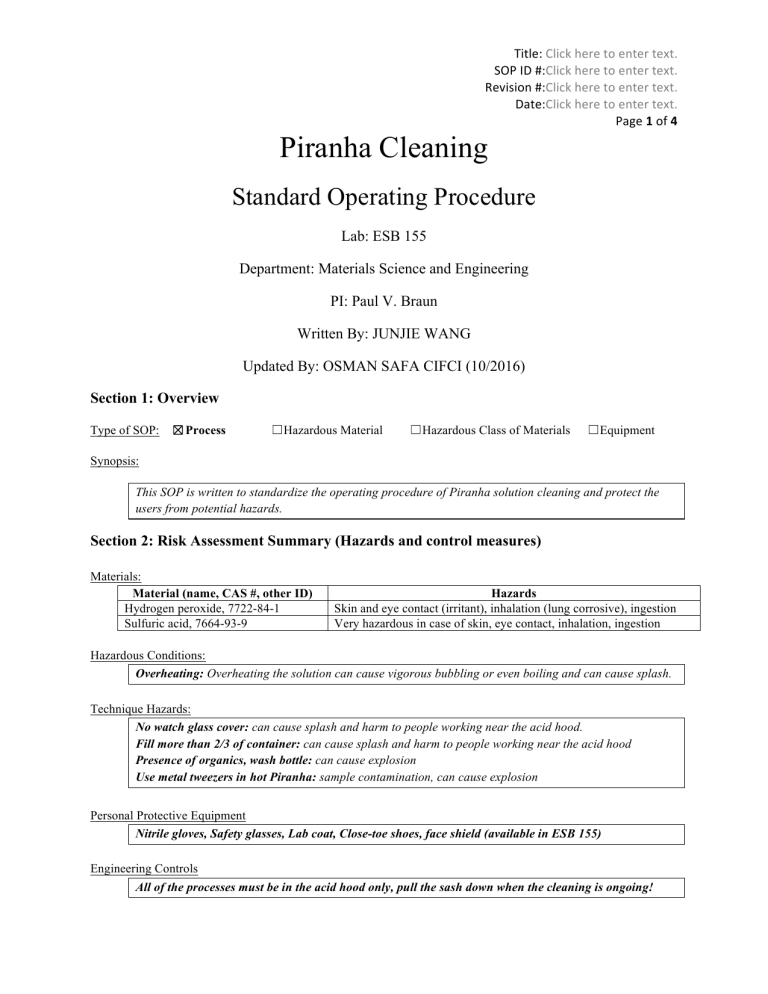
Title: Click here to enter text. SOP ID #:Click here to enter text. Revision #:Click here to enter text. Date:Click here to enter text. Page 1 of 4 Piranha Cleaning Standard Operating Procedure Lab: ESB 155 Department: Materials Science and Engineering PI: Paul V. Braun Written By: JUNJIE WANG Updated By: OSMAN SAFA CIFCI (10/2016) Section 1: Overview Type of SOP: ☒ Process ☐Hazardous Material ☐Hazardous Class of Materials ☐Equipment Synopsis: This SOP is written to standardize the operating procedure of Piranha solution cleaning and protect the users from potential hazards. Section 2: Risk Assessment Summary (Hazards and control measures) Materials: Material (name, CAS #, other ID) Hydrogen peroxide, 7722-84-1 Sulfuric acid, 7664-93-9 Hazards Skin and eye contact (irritant), inhalation (lung corrosive), ingestion Very hazardous in case of skin, eye contact, inhalation, ingestion Hazardous Conditions: Overheating: Overheating the solution can cause vigorous bubbling or even boiling and can cause splash. Technique Hazards: No watch glass cover: can cause splash and harm to people working near the acid hood. Fill more than 2/3 of container: can cause splash and harm to people working near the acid hood Presence of organics, wash bottle: can cause explosion Use metal tweezers in hot Piranha: sample contamination, can cause explosion Personal Protective Equipment Nitrile gloves, Safety glasses, Lab coat, Close-toe shoes, face shield (available in ESB 155) Engineering Controls All of the processes must be in the acid hood only, pull the sash down when the cleaning is ongoing! Title: Click here to enter text. SOP ID #:Click here to enter text. Revision #:Click here to enter text. Date:Click here to enter text. Page 2 of 4 Section 3: Procedures Cleaning procedures: i) ii) iii) iv) v) vi) vii) viii) Sign in the logbook (time, date, name, amount, composition). Put CLEAN and DRY container with samples on hotplate. The samples have to be clean (make sure there is no dirt residue, organics, etc.). Get the H2SO4 from the acid cabinet, add desired amount to the container, put it back. Get the H2O2 from the small refrigerator, add desired amount to the container (H2O2: H2SO4 1:3 by vol.), put it back. Cover the container with watch glass and then turn on the hotplate, set to heating level 5. Wait for about 30 mins (could be longer if necessary), turn off the hotplate, move the container with the watch glass carefully to the side. Wait until the solution cools down, use teflon forceps to hold the samples and rinse with water. Sign out the logbook (time). After 24hours and within 48 hours, Piranha solution should be disposed of into the waste bottle if it will not be reused. The disposed amount needs to be filled after you disposed of the solution. Then check the last column of the logbook after this. For H2SO4/H2O2: NO organics and wash bottles are allowed in the acid hood. Reuse of Piranha solution: Piranha could be reused ONLY for some non-rigorous experiment. Label the container with the date of the first experiment and your name, and when reusing it, add additional H2O2 (no more than 15% by volume). Signing of the logbook is required for reuse of Piranha. All reusable Piranha solutions older than 7 days are required to be disposed of into waste bottle. Section 4: Waste Disposal/Cleanup NEVER dispose of hot Piranha solution. Watch out for spills while wasting Piranha into waste bottle. NEVER close the lid of Piranha waste bottle (leave it open). Clean up after experiment. In case of small spills, use NaHCO3 (at the right hand side of the hood) to neutralize the acid. DO NOT leave empty containers in acid hood. Section 5: Emergency Response i) ii) iii) iv) v) In case of emergency, the victim should be removed from the contaminated area, placed under a safety shower while emergency personal is contacted (911). All contaminated clothing should be removed immediately with appropriate gloves and safely discarded. In case of contact with the skin, the affected area must be immediately rinsed with large amounts of water for at least 15 mins. In case of contact with the eye, irrigate the eye for at least 30 mins, keeping the eyelids apart and away from eyeballs during irrigation. Place ice pack on eyes until reaching emergency room In case of inhalation, it may irritate the respiratory tract. Conscious persons should be assisted to an area with fresh, uncontaminated area. Seek medical attention in the event of respiratory irritation, cough or tightness in the chest. Symptoms may be delayed. Title: Click here to enter text. SOP ID #:Click here to enter text. Revision #:Click here to enter text. Date:Click here to enter text. Page 3 of 4 First-aid kit is available in ESB 155. Section 6: Additional Information Advice: 1. 2. 3. Use the smallest amount of Piranha possible. Try to have someone around if you are doing it off hours. Choose a gentler way of cleaning your samples if you can. Checklist: ☐Read (Material) Safety Data Sheets. ☐Proper fire extinguisher is nearby. ☐Another researcher is nearby and knows the hazards present. ☐All calculations are done prior to beginning the procedure. ☐The required glassware is of the proper size to accommodate all steps of the procedure. Title: Click here to enter text. SOP ID #:Click here to enter text. Revision #:Click here to enter text. Date:Click here to enter text. Page 4 of 4 Training Documentation Signing this document means that you have read and understand all aspects of this Standard Operating Procedure. The supervisor is the person that acknowledges you took the training and understand the procedure. They can be a lab manager or researcher assigned by the PI to oversee this particular SOP. Name (Printed) Name (Signed) Supervisor Date
